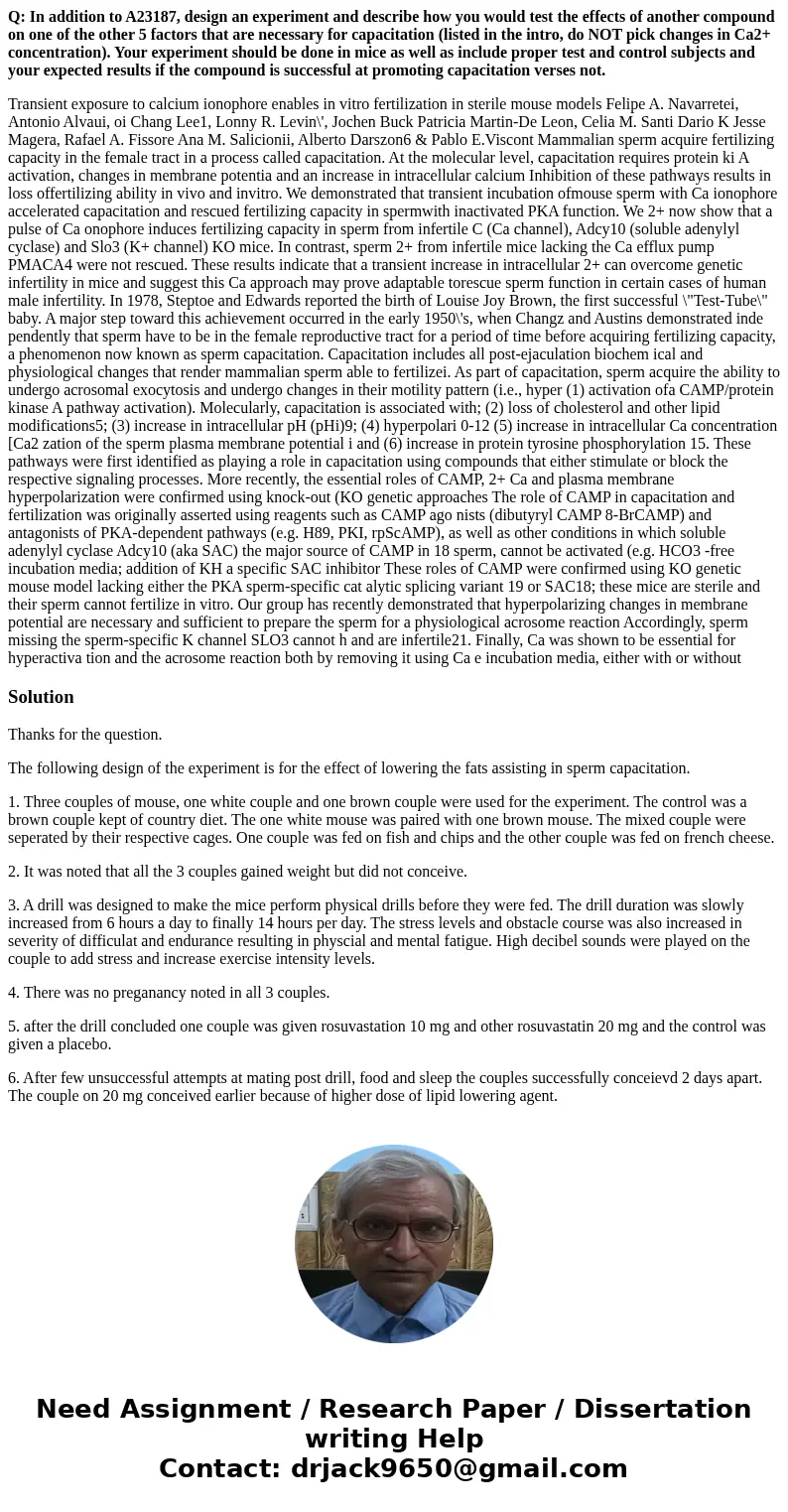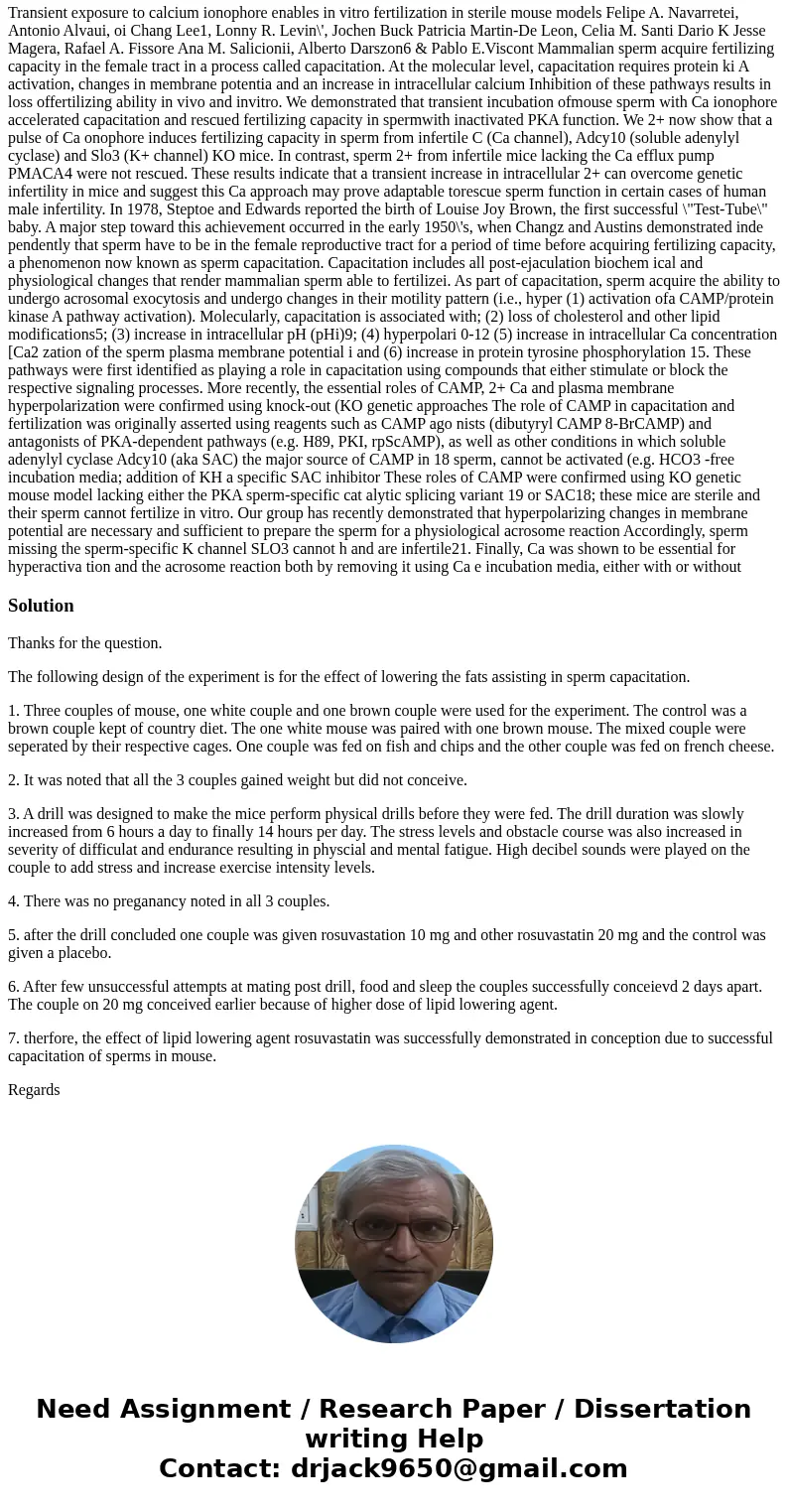Q In addition to A23187 design an experiment and describe ho
Q: In addition to A23187, design an experiment and describe how you would test the effects of another compound on one of the other 5 factors that are necessary for capacitation (listed in the intro, do NOT pick changes in Ca2+ concentration). Your experiment should be done in mice as well as include proper test and control subjects and your expected results if the compound is successful at promoting capacitation verses not.
Transient exposure to calcium ionophore enables in vitro fertilization in sterile mouse models Felipe A. Navarretei, Antonio Alvaui, oi Chang Lee1, Lonny R. Levin\', Jochen Buck Patricia Martin-De Leon, Celia M. Santi Dario K Jesse Magera, Rafael A. Fissore Ana M. Salicionii, Alberto Darszon6 & Pablo E.Viscont Mammalian sperm acquire fertilizing capacity in the female tract in a process called capacitation. At the molecular level, capacitation requires protein ki A activation, changes in membrane potentia and an increase in intracellular calcium Inhibition of these pathways results in loss offertilizing ability in vivo and invitro. We demonstrated that transient incubation ofmouse sperm with Ca ionophore accelerated capacitation and rescued fertilizing capacity in spermwith inactivated PKA function. We 2+ now show that a pulse of Ca onophore induces fertilizing capacity in sperm from infertile C (Ca channel), Adcy10 (soluble adenylyl cyclase) and Slo3 (K+ channel) KO mice. In contrast, sperm 2+ from infertile mice lacking the Ca efflux pump PMACA4 were not rescued. These results indicate that a transient increase in intracellular 2+ can overcome genetic infertility in mice and suggest this Ca approach may prove adaptable torescue sperm function in certain cases of human male infertility. In 1978, Steptoe and Edwards reported the birth of Louise Joy Brown, the first successful \"Test-Tube\" baby. A major step toward this achievement occurred in the early 1950\'s, when Changz and Austins demonstrated inde pendently that sperm have to be in the female reproductive tract for a period of time before acquiring fertilizing capacity, a phenomenon now known as sperm capacitation. Capacitation includes all post-ejaculation biochem ical and physiological changes that render mammalian sperm able to fertilizei. As part of capacitation, sperm acquire the ability to undergo acrosomal exocytosis and undergo changes in their motility pattern (i.e., hyper (1) activation ofa CAMP/protein kinase A pathway activation). Molecularly, capacitation is associated with; (2) loss of cholesterol and other lipid modifications5; (3) increase in intracellular pH (pHi)9; (4) hyperpolari 0-12 (5) increase in intracellular Ca concentration [Ca2 zation of the sperm plasma membrane potential i and (6) increase in protein tyrosine phosphorylation 15. These pathways were first identified as playing a role in capacitation using compounds that either stimulate or block the respective signaling processes. More recently, the essential roles of CAMP, 2+ Ca and plasma membrane hyperpolarization were confirmed using knock-out (KO genetic approaches The role of CAMP in capacitation and fertilization was originally asserted using reagents such as CAMP ago nists (dibutyryl CAMP 8-BrCAMP) and antagonists of PKA-dependent pathways (e.g. H89, PKI, rpScAMP), as well as other conditions in which soluble adenylyl cyclase Adcy10 (aka SAC) the major source of CAMP in 18 sperm, cannot be activated (e.g. HCO3 -free incubation media; addition of KH a specific SAC inhibitor These roles of CAMP were confirmed using KO genetic mouse model lacking either the PKA sperm-specific cat alytic splicing variant 19 or SAC18; these mice are sterile and their sperm cannot fertilize in vitro. Our group has recently demonstrated that hyperpolarizing changes in membrane potential are necessary and sufficient to prepare the sperm for a physiological acrosome reaction Accordingly, sperm missing the sperm-specific K channel SLO3 cannot h and are infertile21. Finally, Ca was shown to be essential for hyperactiva tion and the acrosome reaction both by removing it using Ca e incubation media, either with or withoutSolution
Thanks for the question.
The following design of the experiment is for the effect of lowering the fats assisting in sperm capacitation.
1. Three couples of mouse, one white couple and one brown couple were used for the experiment. The control was a brown couple kept of country diet. The one white mouse was paired with one brown mouse. The mixed couple were seperated by their respective cages. One couple was fed on fish and chips and the other couple was fed on french cheese.
2. It was noted that all the 3 couples gained weight but did not conceive.
3. A drill was designed to make the mice perform physical drills before they were fed. The drill duration was slowly increased from 6 hours a day to finally 14 hours per day. The stress levels and obstacle course was also increased in severity of difficulat and endurance resulting in physcial and mental fatigue. High decibel sounds were played on the couple to add stress and increase exercise intensity levels.
4. There was no preganancy noted in all 3 couples.
5. after the drill concluded one couple was given rosuvastation 10 mg and other rosuvastatin 20 mg and the control was given a placebo.
6. After few unsuccessful attempts at mating post drill, food and sleep the couples successfully conceievd 2 days apart. The couple on 20 mg conceived earlier because of higher dose of lipid lowering agent.
7. therfore, the effect of lipid lowering agent rosuvastatin was successfully demonstrated in conception due to successful capacitation of sperms in mouse.
Regards


 Homework Sourse
Homework Sourse